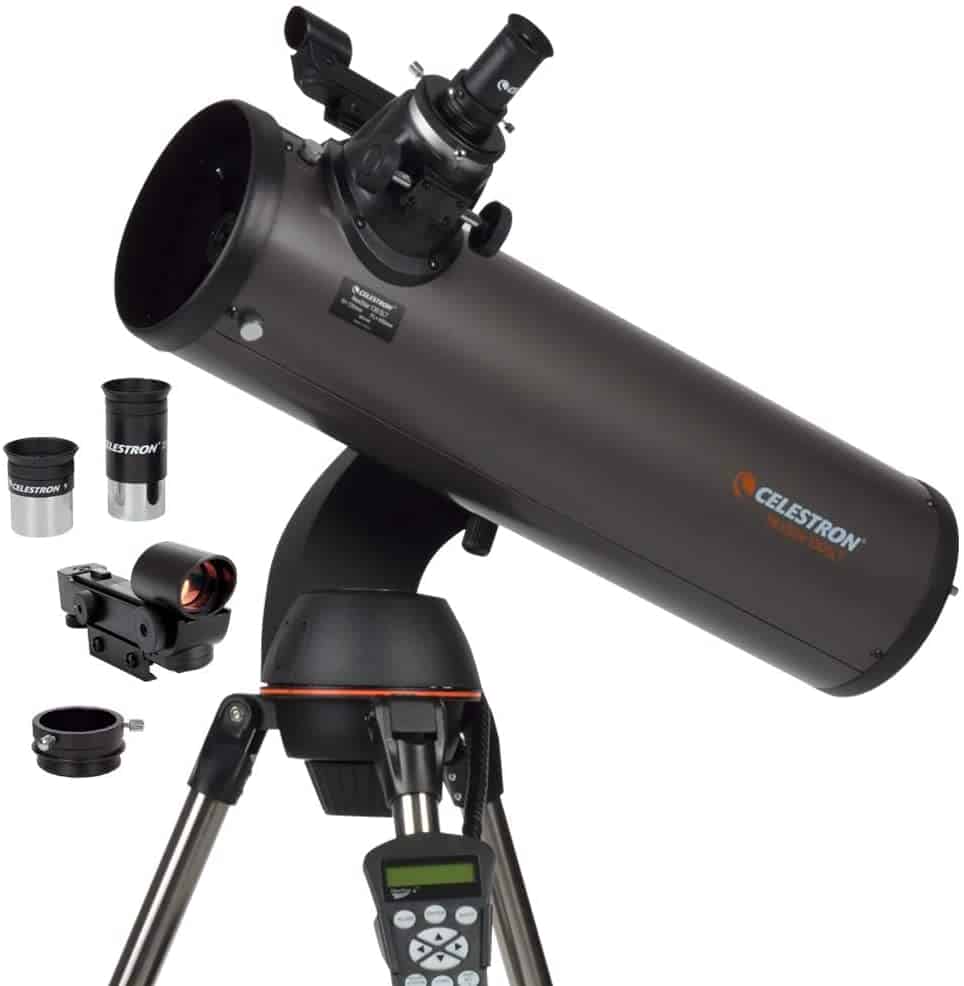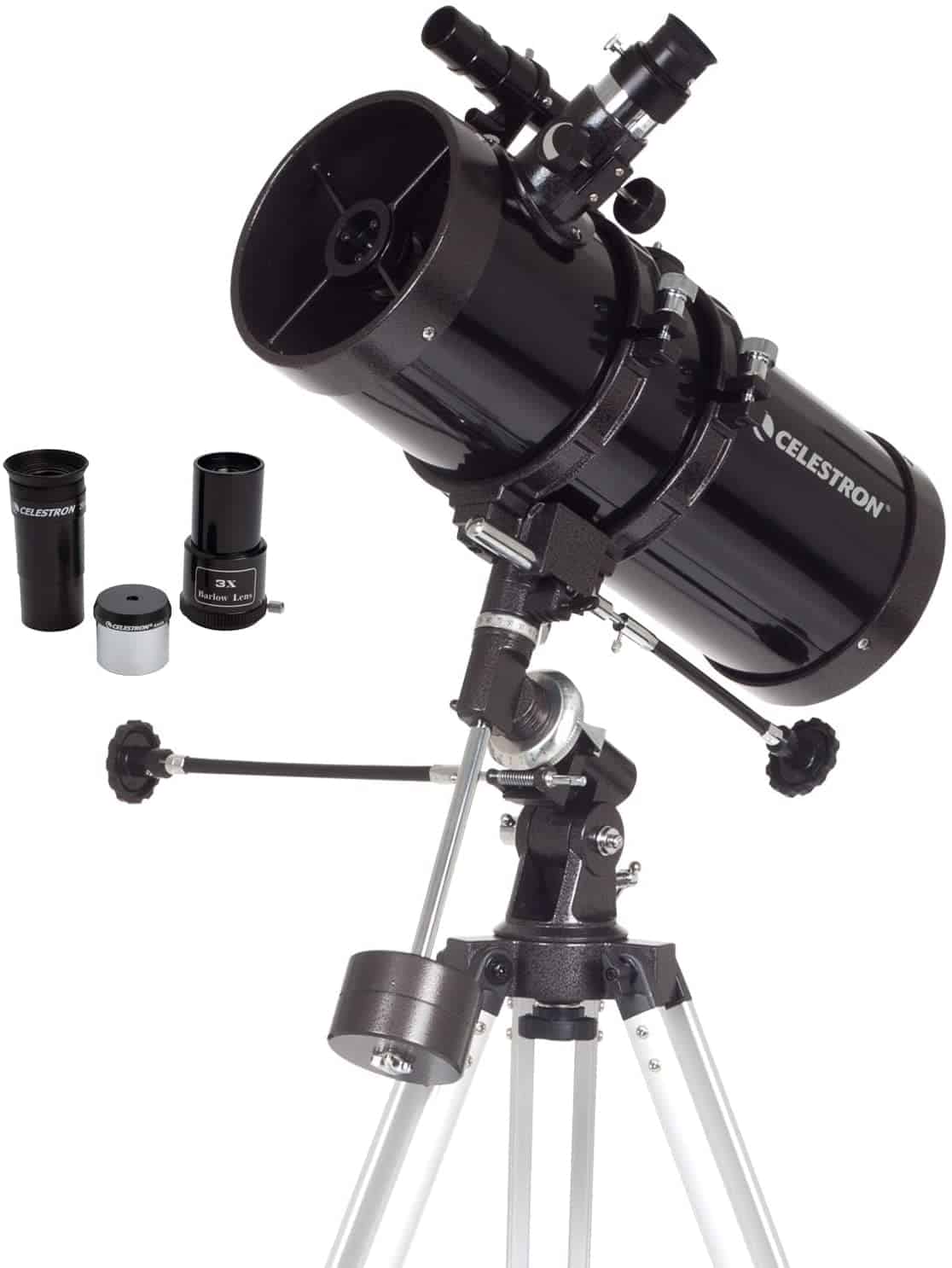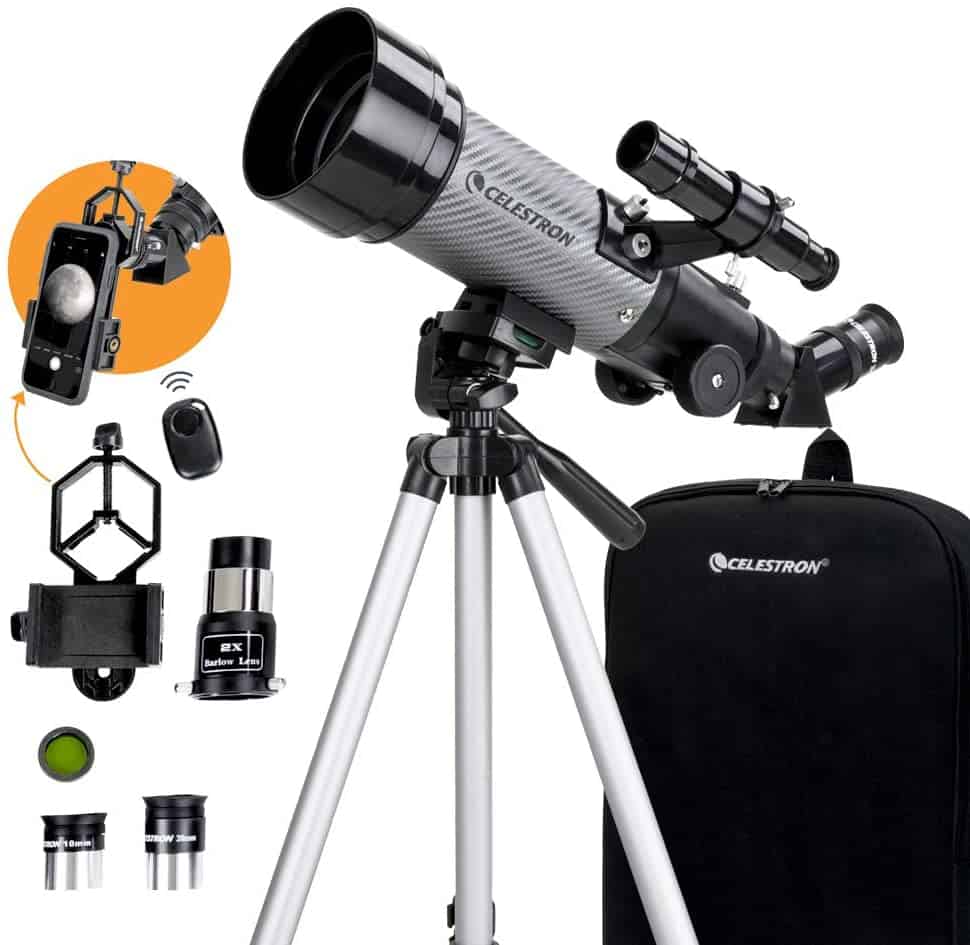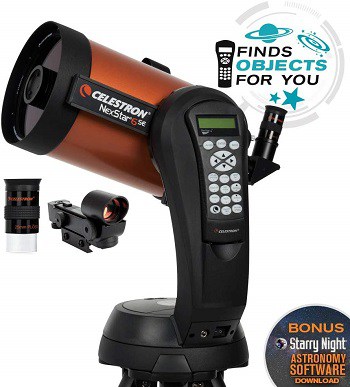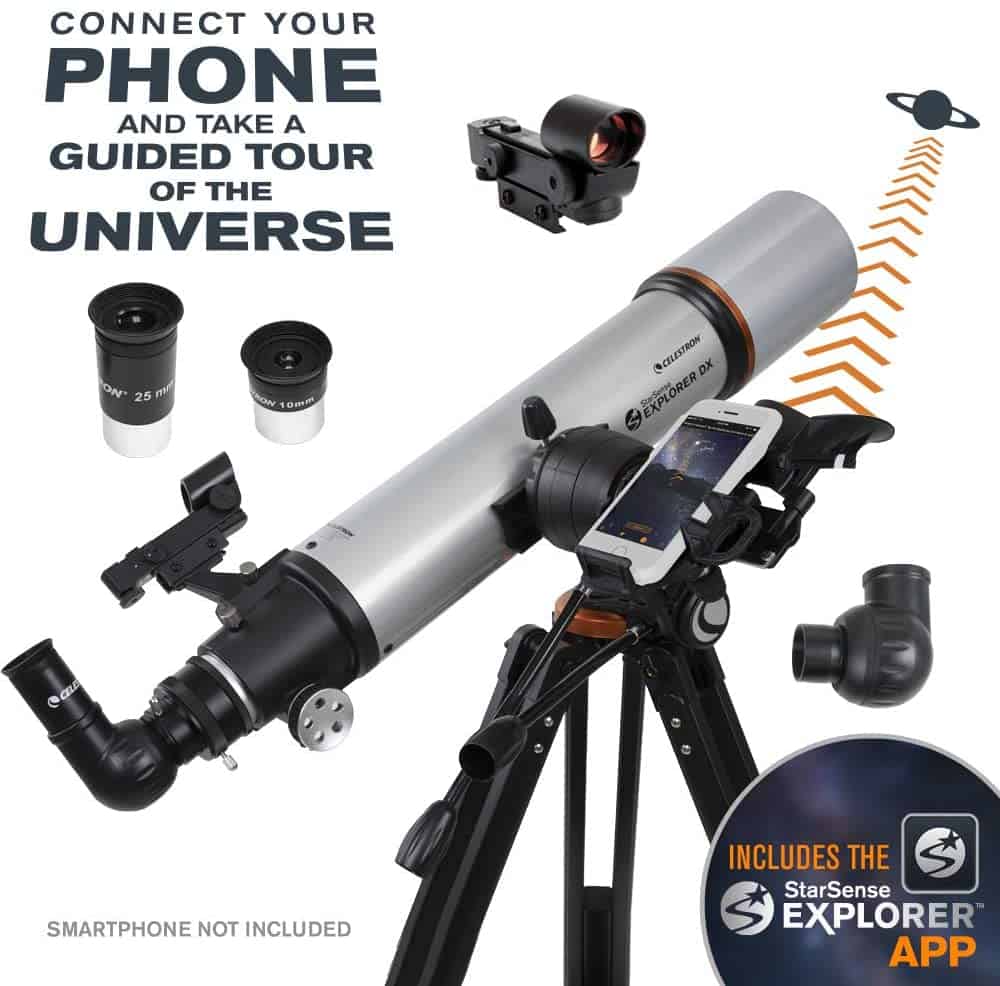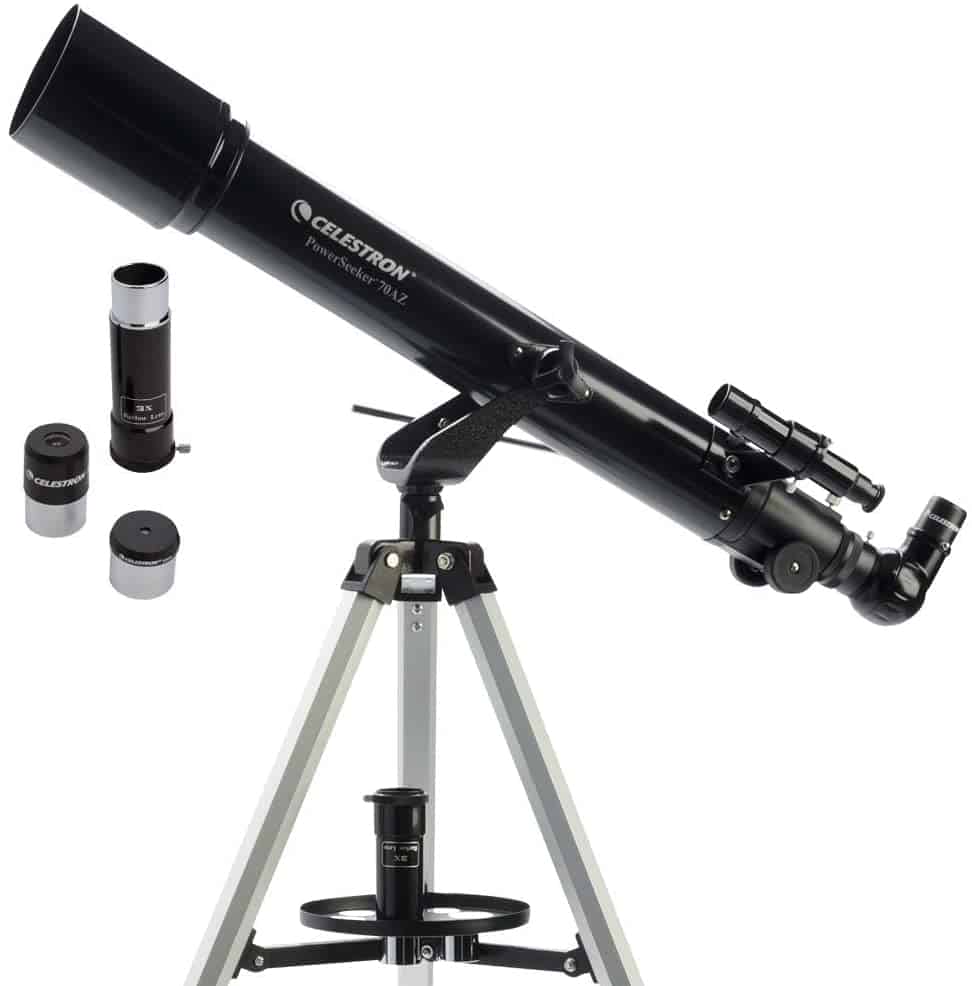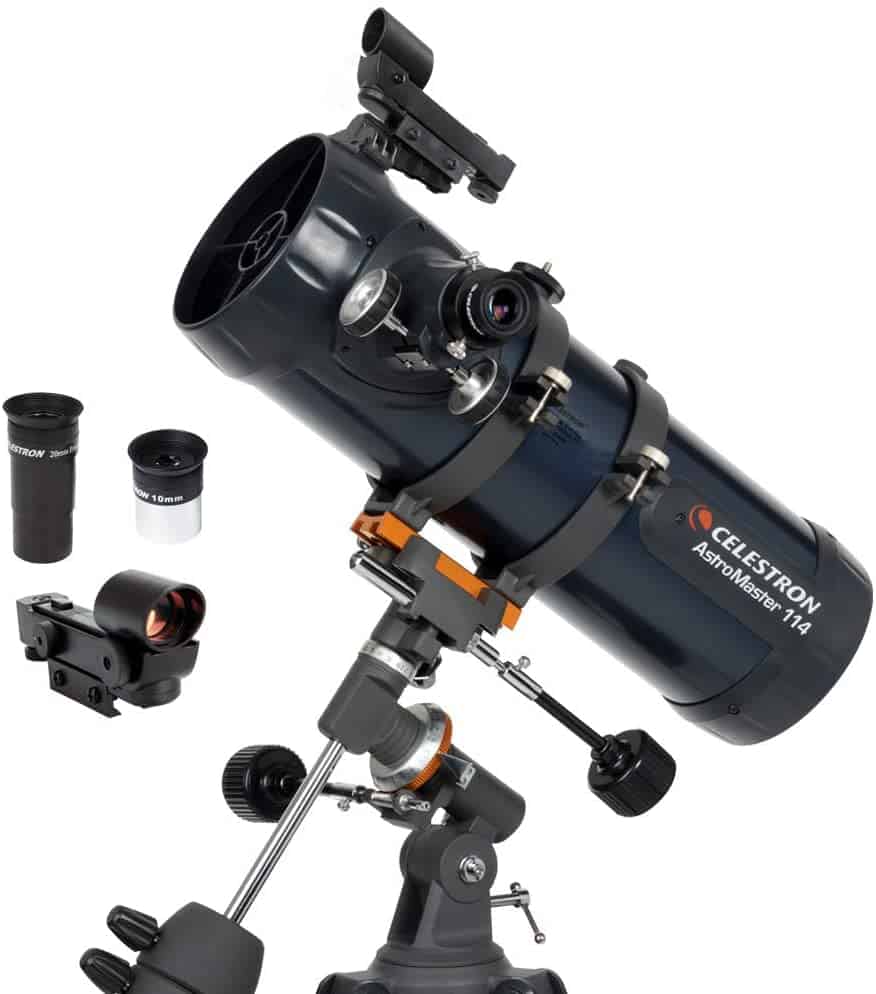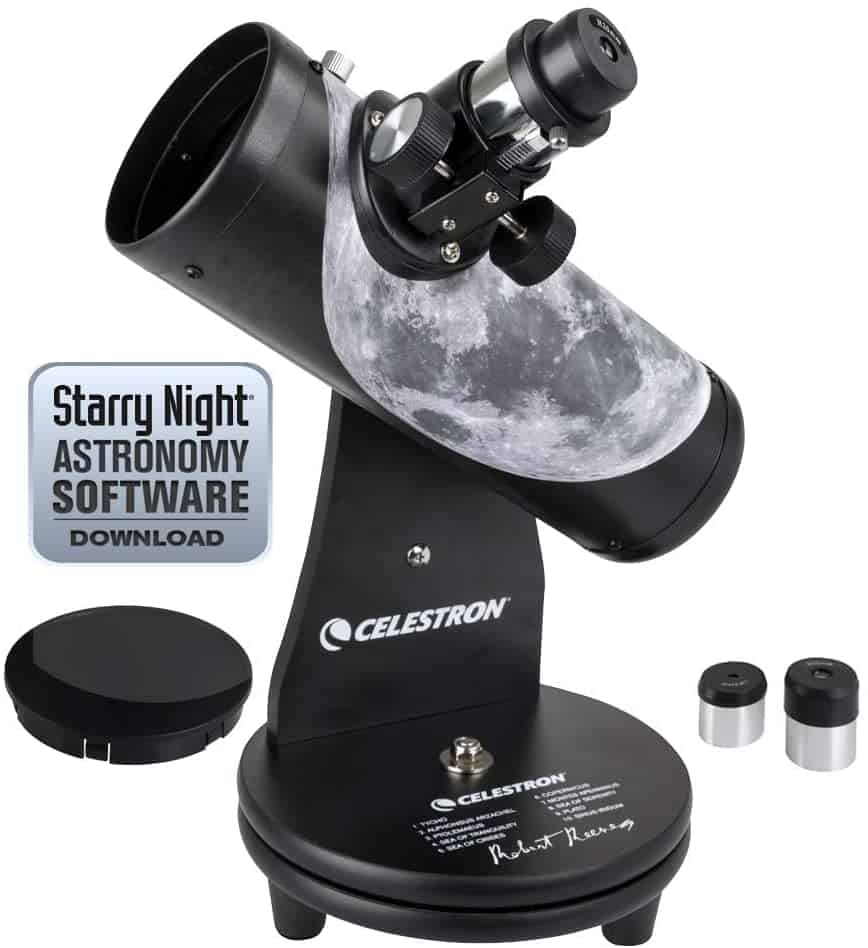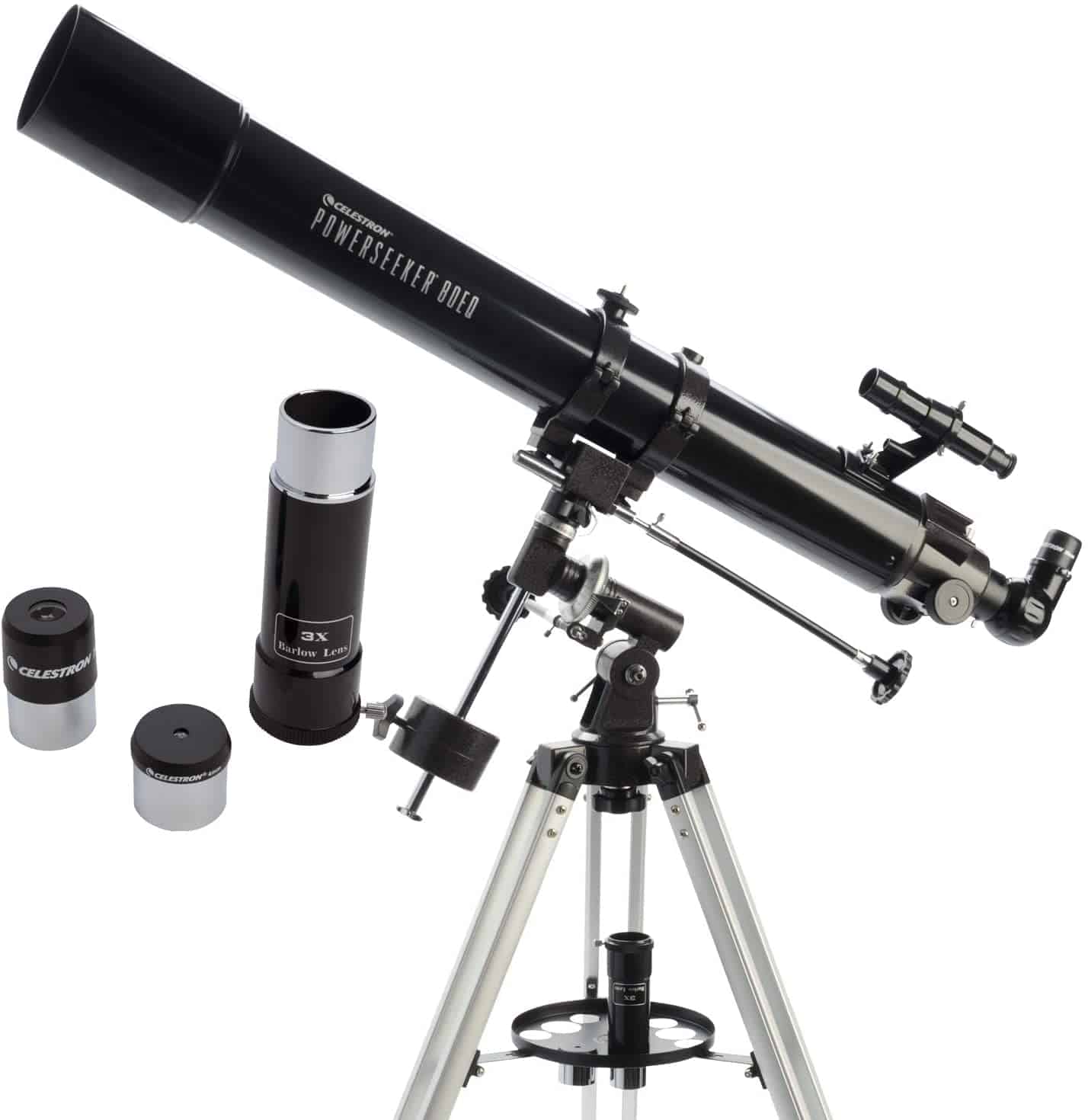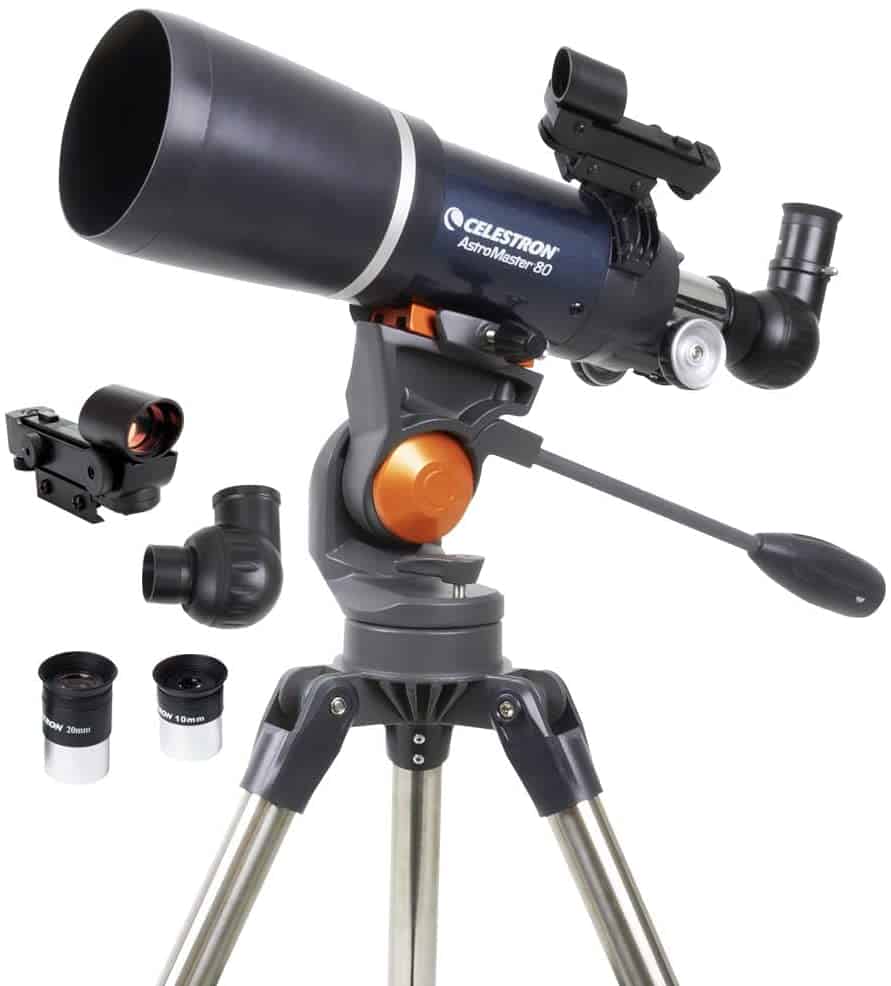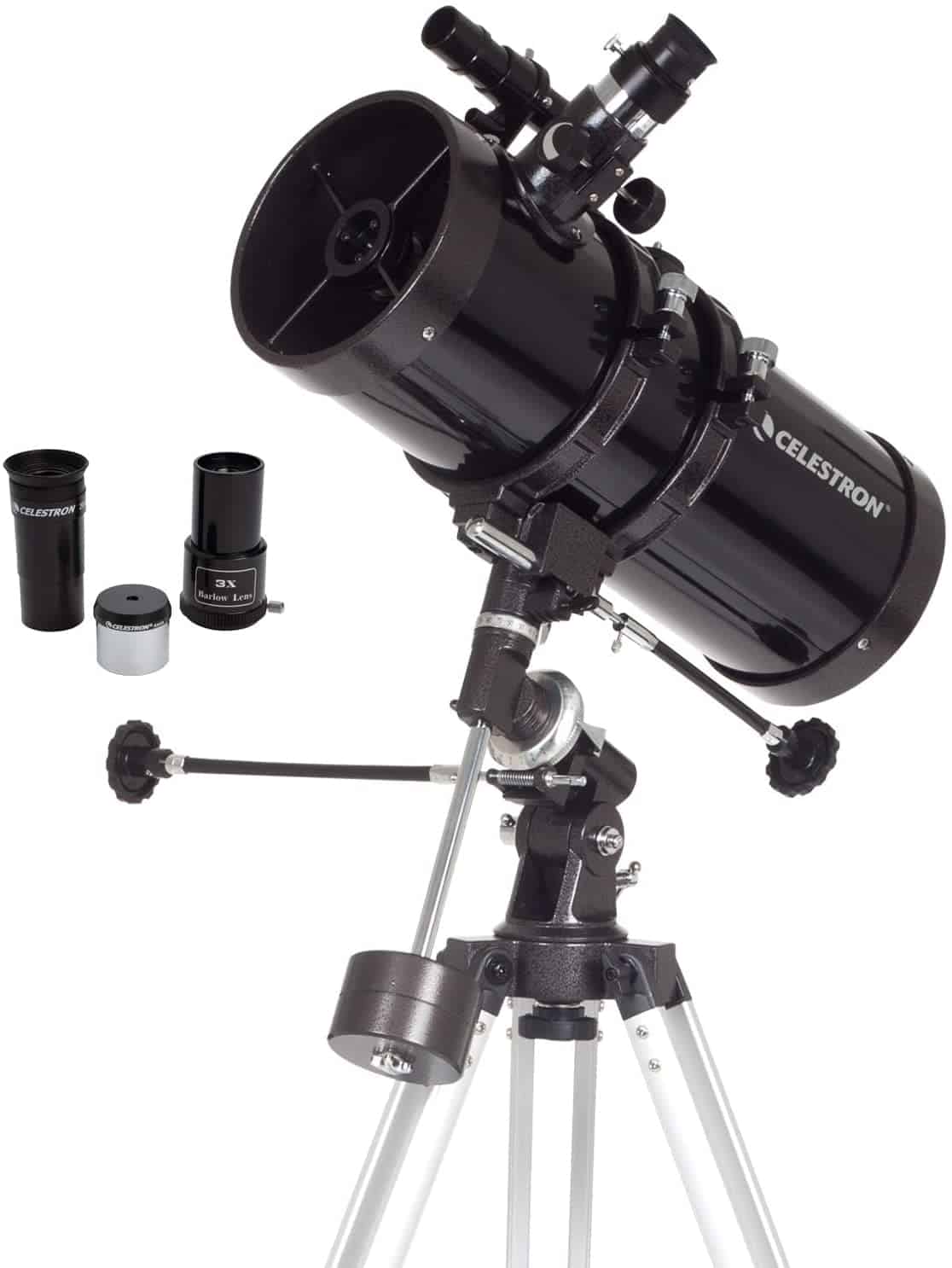Imagine having the ability to peek behind the curtain of the sky into the unlimited abyss with mysterious floating objects that store the secrets of our reality in them.
Optical devices have come a long way since the first camera was invented that captured the beauties of nature for the first time. In this advanced era, we now have access to such liberating devices that can enable us to have a peek at the seemingly faraway celestial objects.
A telescope is such a device that has the ability to enable your eyes to see the never-ending space that exists just above our heads beyond the curtains of skies. The asteroids, nebulae, stars, and planets are just a purchase away of a telescope for you to explore.
We have found after excessive research the Best Celestron Telescopes for you to choose your ultimate exploratory buddy.
Let’s get started!
Our Overall #1 Rated Pick
Who would not want a computerized telescope which offers a database of loads of galaxies, stars, and nebulae? This telescope has an eyepiece of 2 inches and can locate and track objects with high precision and accuracy
This telescope can be used by both kids and adults for the excursions to dark sky sites or camping trips. We can see our solar system, Jupiter’s cloud bands, Saturn’s rings, and the moon in brilliant detail by the 130mm aperture.
The 10 Best Telescopes Comparison Chart
Image | Product Name | Ranking | Price |
|---|---|---|---|
1 4.10 | |||
2 4.00 | |||
3 4.40 | |||
4 4.20 | |||
5 4.20 | |||
6 4.10 | |||
7 4.10 | |||
8 4.00 | |||
9 4.20 | |||
10 4.50 |
The 10 Best Celestron Telescope Out There
In this section, we review the Top 10 Celestron Telescope available for amateurs and professions.
Who would not want a computerized telescope which offers a database of loads of galaxies, stars, and nebulae? This telescope has an eyepiece of 2 inches and can locate and track objects with high precision and accuracy
This telescope can be used by both kids and adults for the excursions to dark sky sites or camping trips. We can see our solar system, Jupiter’s cloud bands, Saturn’s rings, and the moon in brilliant detail by the 130mm aperture.
The SkyAlign feature ensures that the setup of the telescope is fast, and it can be ready in two minutes. With this telescope, you get two eyepieces (25mm and 9mm), a red dot StarPointer finderscope, an adjustable and full-height steel tripod that has a tray to keep you organized in the field.
PROS
CONS
Are you a beginner and love celestial objects? Then, Celestron - PowerSeeker 127EQ Telescope is what you are seeking. It provides newcomers the perfect combination of power, quality, features, and value. It is effortless to handle.
The telescope comes with a German Equatorial mount. This mount is used for smooth and accurate pointing. You can adjust the rod to your desired position and then keep the position required by tightening the cross knobs present on it.
It can be used both by kids and adults. It is light in weight and can be taken for camping, star gazing, etc. The package includes a 3x Barlow lens to multiply the power of each eyepiece (4mm and 20mm). You can also download the Astronomy Starry Night Software Package.
PROS
CONS
The Celestron Travel Scope features a 70mm objective lens, high-quality, fully-coated glass optics, a lightweight frame, and a backpack. It consists of two high-quality eyepieces (10mm and 20mm), which provide views of terrestrial objects during the daytime and celestial objects at night.
It has an objective lens with a 70mm large aperture. You can take the telescope anywhere, as it is lightweight and portable. The accessories in the package include a tripod, a bonus bag, a moon filter, Bluetooth shutter, 2x Barlow, a smartphone adapter, and astronomy software.
With this product, you get a warranty of two years and access to the technical team. What more can you ask for?
PROS
CONS
The NexStar 6SE Telescope is computerized and comes with updated technology. It is perfect for both kids and adults. It can show us more than 40,000 celestial objects.
Moreover, it has a fast operation. The sturdy, high-quality steel tripod and the single fork arm can be broken down into parts for easy transportation when you go out camping or on stargazing excursions. You can align your telescope with the help of SkyAlign technology in minutes.
You get free access to the starry night software for astronomy as well. The product has a warranty of two years and access to the technical team in case of any difficulties.
PROS
CONS
Celestron – StarSense Explorer DX is unique in the sense that it can connect to your iPhone or Android phone to guide you on the tour of the night sky. You just have to follow the arrows to locate stars, galaxies, sun, planets & more!
You can view planets, galaxies, brighter nebulae, star clusters from the city, and fainter sky objects from deep and darker locations. It is very easy to use. The smooth, dual-axis slow-motion controls of the Manual altazimuth mount makes it easy for you to follow the arrows on the screen to your target.
PROS
CONS
The Celestron PowerSeeker 70AZ is the perfect combination of affordability, quality, and power. It is sturdy and easy to use. Using this refractor telescope, you can easily navigate the skies. For smooth and accurate pointing, a slow-motion altitude rod attached to the mount is used.
You can adjust the rod to the desired position by tightening the cross knob. The telescope can be used by both kids and adults. It can be taken out with you when you are going camping, or you can stargaze right from the comforts of your backyard.
The package includes two eyepieces (4mm and 20mm), a finderscope, erect image diagonal, plus a 3x Barlow lens to multiply the power.
PROS
CONS
This is a user friendly and powerful telescope. It has two eyepieces, fully-coated glass optics, a StarPointer red dot finderscope, a sturdy and lightweight frame, and an adjustable tripod. At the core of the system is a 114mm primary mirror which is fully-coated.
It comes with the AstroMaster mount having two control knobs that help you see precise adjustments of terrestrial and celestial objects.
It has an easy setup and can be used by both kids and adults.it has a lightweight frame. The package includes a tripod stand, two eyepieces (10mm and 20mm), and a StarPointer red dot finderscope.
PROS
CONS
The Celestron Signature Series Moon Astronomical Telescope is a masterpiece. It is a high-quality Dobsonian tabletop telescope. The reflector telescope has a spherical glass mirror and a large aperture of 76 mm.
The wide FOV provides us with sharp, bright views of the craters on the Moon in crisp detail. Moreover, you can enjoy watching Saturn's rings, exploring the Milky Way, and gazing at other deep-sky objects.
The simple and portable design of this telescope ensures that all levels of astronomers, beginners and professionals, can use it comfortably. With this telescope, you get a free PDF of the ebook by Robert Reeves, the Lunar landscapes.
When you want to go camping or on a stargazing trip with your friends and family, this telescope is your best friend!
You don’t need to go through a tough assembly process: simply take the telescope out of the box, attach the eyepiece and you are good to go!
PROS
CONS
Are you interested in the celestial objects and want to lose yourself in the mysteries of the heavens above? Then, you are in the right place. This product is for you. You can quench your thirst for stargazing with the help of this product.
Celestron - PowerSeeker 80EQ Telescope is very easy to handle and can be used by both kids and adults. For the beginners, this product is the amalgam of quality, features, value, and power. It has a German manual mount which has a slow-motion rod for accurate pointing of the object.
The package includes two eyepieces (4mm and 20mm, finderscope, erect image diagonal, and a 3x Barlow lens to multiply the power.
PROS
CONS
The Celestron astromaster 80AZS refractor telescope is a user-friendly and powerful refractor telescope. It has fully-coated glass optics, two eyepieces, a strong and lightweight frame, an adjustable tripod, a star pointer, and a red dot finderscope.
The telescope has an 80mm primary mirror which is a fully-coated. This product is both for beginners and adults. For accurate and smooth pointing, it comes with a manual altazimuth mount. It has an easy setup where no tools are required.
You also get a tripod and an erect image star diagonal with this telescope. Moreover, you get a two years warranty.
PROS
CONS
Best Celestron Telescope - Buying Guide
A telescope is a complicated device as it entails many features that need a comprehensive explanation before a person can easily understand those aspects. Since the middle of the twentieth century, this quest of exploring the unknown parts of the universe with the help of telescopes has started, and now it has evolved into a norm with people belonging to all fields purchasing and quenching their thirst for knowledge about the mysterious space that lies above us.
It is essential to understand these basic components of the telescope and its basic functionality to not fall victim to a scam or to not unknowingly make a mistake by purchasing the wrong model of this optical device.
After hours of searching through the internet and evaluating every basic requirement, we have created this buying guide that will help you with the device at hand.
Let’s get started!
About Celestron
Celestron is a company majoring in various optical devices, the front runners of their success and their specialty are telescopes. Celestron has been in this game for decades, and they have proved their worth with quality optical devices on multiple occasions. There is a wide range of telescopes offered by Celestron some of which are mentioned below;
- 5-14-inch Schmidt Cassegrain Telescopes
- 8-14-inch modified Schmidt Cassegrain Telescopes
- 2.4-6-inch Refractor Telescopes
- 6-10-inch Traditional Newtonian Reflector Telescopes
Celestron is one of the leading brands in the market and has achieved this status by constantly improving its technological game with advanced telescopes that comply with the current needs and options of society.
Systemic Controls (star mapping)
Although a smaller field of view makes it a little difficult to cover a larger surface area if you do not know the exact location of the star or nebulae you are looking for, this problem can be easily solved with star mapping technology.
As every little thing around us has been digitalized with automatic controls similarly, Celestron telescopes have evolved as well with built-in systemic controls. These systemic controls have digital maps of locations of almost all celestial objects and can be easily displayed in earth coordinates so you can reach the perfect destination as well as easily spot the star you so want to study.
Star mapping is an incredible life-saver for anyone who is a newbie to the astronomical world and does not understand how to correctly position their telescope to enhance its features as well as not miss the meteor showers.
It greatly helps us in positioning the aperture of the telescope to the right angle in the right position to facilitate and fulfill your requirements.
Aperture
The wide distal end of the telescope that holds the primary lens or primary mirror is called the aperture. Recalling the basic mechanism of a telescope, we find that these devices work by capturing light rays falling from distant objects and then display them on the focal point.
The ability of a telescope to capture the number of light rays depends upon the aperture. The wider the aperture, the more surface area there will be for the light to fall on, and thus more light rays could be collected to produce a higher quality image of the distant body.
Another way the aperture holds its place as a vital component of the system is by attracting the light rays from the nearby sources to illuminate the objective field. This aspect of a wider aperture helps in producing a brighter and clearer image in a dark field or at night time.
The information about the width of the aperture is mentioned along with the magnification power, preferably in inches.
Magnification Power
The most prominent function of a telescope is to make distant objects appear closer to the naked eye, and this function is performed according to the magnification power of the device. The information about magnification power is mentioned along with the aperture size in this format ‘x80’.
This entails that the particular image of a celestial body will be magnified 80 times in the eyepiece. The higher the magnification power, the more detailed image will be produced on the focal plane; thus, the clearer image will be projected in the eyepiece.
The magnification power has a direct relation with focal length and inverse relation with the field of view of a telescope. Before purchasing any telescope, you should review your needs. There are a variety of objects in deep space lying at different lengths away from earth, so there are different types of telescopes that may fulfill your needs.
Focal Length
The distance from the center of the primary lens to the focal point where the image is projected is called the focal length. In an advanced telescope, there may be many lenses or mirrors that may stand in the way of the light rays passing through the focal length of a spherical tube of a telescope, but their existence does not pose an obstruction.
The focal length is the primary determinant of the magnification power of a telescope. As we continue to find out more ways to enhance the magnifying power, one way we continue to do so is by increasing the focal length, which often entails that the length of the spherical tube is increased drastically.
The focal length is the distance the light rays have to travel after entering through the aperture into the spherical tube before being projected onto the focal plane. The magnification power and the focal point have a direct relationship, but often, they are mentioned separately.
Portability
Often the great astronomical events can only be viewed, even with the help of a telescope, from deserted areas or high planes. The mystical events such as meteor showers that only happen once or twice every decade are way too special for astronomy fanatics to miss because of the obstruction from the artificial lights of the city.
Since these important events require moving and often hiking through trails to reach the required destination to view the desired star or celestial object, one cannot fathom just trailing to a distant point without taking their professional equipment.
A telescope is a heavy device and also requires a ton of accessories to show optimum functionality. A telescope that can be easily assembled and broken down into safe components is essential for preserving its vitality during transportation.
This aspect also makes it easier to bring about your telescope almost everywhere. A telescope is a very delicate object as it depends on a variety of mirrors and lenses to perform its highly convoluted action. It requires attention and utmost care while traveling.
Thus, just like all our other technical devices, a bag that is specifically made to transport a telescope, along with its accessories, is vital. Although it comes in the category of extra accessories, most companies include a travel helping bag in the entire package of a telescope.
Accessories
There is no optical device in the world whose function cannot be enhanced with the addition of a few accessories. Especially the functional ability of a telescope is greatly vitalized with the help of a few essential accessories.
The two most vital accessories that are an absolute must for a telescope are:
- Base support
- Tripod stand
Both of these accessories aid stability and increase the practicability of a telescope. A tripod stand also increases comfortability as one can adjust the length of the stand to suit your posture since astronomical events often take a long time to appear, so comfort and patience are key aspects of this field.
Base support is just a tool to increase stability even on uneven grounds as it can be modified according to the receiving surface. A mount is a stability device that goes on top of the telescope. It creates a steady connection between the tripod stand and the telescope so that even in case of minor accidents, the device does not slip out of its stand.
Field of View
The field of view of an optical device is the amount of area it can cover at any given instant. To further simplify this concept, consider a human eye, it has a field of view of 180 degrees. Any normal human has the magical ability to see sideways.
This ability to view almost everything on our temporal side is called peripheral vision, and it is granted due to our curved cornea. First of all, the primary lens of a telescope is not curved outward, so the question of it being able to view an object on its side is almost nullified.
Secondly, when any field is being magnified, the field of view gets smaller so as to focus on intricate details of the object. As we want to study every detail of the object we are trying to view from our place on earth, it is better to have a telescope with a smaller field of view.
As we have mentioned earlier, the magnification power has an inverse relation with the field of view, so the higher the magnification power, the smaller field of view a telescope entails.
FAQs
Do objects appear in a telescope as they appear on photographs taken from satellites?
The images that are taken by satellites are taken with the help of state of the art high-resolution cameras, and the distance between the satellite and the planetary body is not a lot.
Due to these advantages, often the photographs from satellites have greater quality, and that is one of the major reasons scientists have adopted this method to study celestial objects.
Should I compromise on the width of the aperture, or is it extremely important to purchase a wide aperture telescope?
The diameter of the objective lens holds extreme importance as we have thoroughly explained its vitality in the buying guide. If you plan on keeping the telescope for a while and use it for research purposes, then it is essential that you must not compromise on this quality.
But if it is only a gift for a minor to initiate their interest in the field of astronomy, then you can purchase a telescope with a little less width of the aperture than usual.
Best Celestron Telescopes – Final Word
It is quite magical that we exist in a universe that is ever-expanding and contains no boundary with endless existence of milky ways and blackholes just a few light-years away from this habitable planet. The secrets of our existence and mystical objects that somehow have debilitating or invigorating effects on our lives are not as out of reach as we think they are.
The best Celestron telescopes can help us have a peek at the truth of the universe. They can help us observe the moon that controls the ocean tides; they can help us view the magical asteroids and stars that so eloquently exist in perfect harmony.
When all of this is just a mere peek away, then why shall we limit our tendencies to explore the abyss and find the purpose of our reality?
Happy Stargazing, People!

